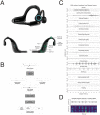A pilot study of the Earable device to measure facial muscle and eye movement tasks among healthy volunteers
- PMID: 36812552
- PMCID: PMC9931353
- DOI: 10.1371/journal.pdig.0000061
A pilot study of the Earable device to measure facial muscle and eye movement tasks among healthy volunteers
Abstract
The Earable device is a behind-the-ear wearable originally developed to measure cognitive function. Since Earable measures electroencephalography (EEG), electromyography (EMG), and electrooculography (EOG), it may also have the potential to objectively quantify facial muscle and eye movement activities relevant in the assessment of neuromuscular disorders. As an initial step to developing a digital assessment in neuromuscular disorders, a pilot study was conducted to determine whether the Earable device could be utilized to objectively measure facial muscle and eye movements intended to be representative of Performance Outcome Assessments, (PerfOs) with tasks designed to model clinical PerfOs, referred to as mock-PerfO activities. The specific aims of this study were: To determine whether the Earable raw EMG, EOG, and EEG signals could be processed to extract features describing these waveforms; To determine Earable feature data quality, test re-test reliability, and statistical properties; To determine whether features derived from Earable could be used to determine the difference between various facial muscle and eye movement activities; and, To determine what features and feature types are important for mock-PerfO activity level classification. A total of N = 10 healthy volunteers participated in the study. Each study participant performed 16 mock-PerfOs activities, including talking, chewing, swallowing, eye closure, gazing in different directions, puffing cheeks, chewing an apple, and making various facial expressions. Each activity was repeated four times in the morning and four times at night. A total of 161 summary features were extracted from the EEG, EMG, and EOG bio-sensor data. Feature vectors were used as input to machine learning models to classify the mock-PerfO activities, and model performance was evaluated on a held-out test set. Additionally, a convolutional neural network (CNN) was used to classify low-level representations of the raw bio-sensor data for each task, and model performance was correspondingly evaluated and compared directly to feature classification performance. The model's prediction accuracy on the Earable device's classification ability was quantitatively assessed. Study results indicate that Earable can potentially quantify different aspects of facial and eye movements and may be used to differentiate mock-PerfO activities. Specially, Earable was found to differentiate talking, chewing, and swallowing tasks from other tasks with observed F1 scores >0.9. While EMG features contribute to classification accuracy for all tasks, EOG features are important for classifying gaze tasks. Finally, we found that analysis with summary features outperformed a CNN for activity classification. We believe Earable may be used to measure cranial muscle activity relevant for neuromuscular disorder assessment. Classification performance of mock-PerfO activities with summary features enables a strategy for detecting disease-specific signals relative to controls, as well as the monitoring of intra-subject treatment responses. Further testing is needed to evaluate the Earable device in clinical populations and clinical development settings.
Copyright: © 2022 Wipperman et al. This is an open access article distributed under the terms of the Creative Commons Attribution License, which permits unrestricted use, distribution, and reproduction in any medium, provided the original author and source are credited.
Conflict of interest statement
The authors have read the journal’s policy and the authors of this manuscript have the following competing interests: MFW, KFM, XW, YC, OL, AA, SCH, RA, and OH are current or former employees and shareholders of Regeneron Pharmaceuticals, Inc. GP, RRD, and TV are employees of Earable, Inc.
Figures



Similar articles
-
Residual one-dimensional convolutional neural network for neuromuscular disorder classification from needle electromyography signals with explainability.Comput Methods Programs Biomed. 2022 Nov;226:107079. doi: 10.1016/j.cmpb.2022.107079. Epub 2022 Aug 24. Comput Methods Programs Biomed. 2022. PMID: 36191354
-
Evaluating Convolutional Neural Networks as a Method of EEG-EMG Fusion.Front Neurorobot. 2021 Nov 23;15:692183. doi: 10.3389/fnbot.2021.692183. eCollection 2021. Front Neurorobot. 2021. PMID: 34887739 Free PMC article.
-
Earable POCER: Development of a Point-of-Care Ear Sensor for Respiratory Rate Measurement.Sensors (Basel). 2018 Sep 10;18(9):3020. doi: 10.3390/s18093020. Sensors (Basel). 2018. PMID: 30201861 Free PMC article.
-
Wheelchair control for disabled patients using EMG/EOG based human machine interface: a review.J Med Eng Technol. 2021 Jan;45(1):61-74. doi: 10.1080/03091902.2020.1853838. Epub 2020 Dec 11. J Med Eng Technol. 2021. PMID: 33302770
-
Eye-Tracking Feature Extraction for Biometric Machine Learning.Front Neurorobot. 2022 Feb 1;15:796895. doi: 10.3389/fnbot.2021.796895. eCollection 2021. Front Neurorobot. 2022. PMID: 35177973 Free PMC article. Review.
Cited by
-
Wearable Orofacial Technology and Orthodontics.Dent J (Basel). 2023 Jan 10;11(1):24. doi: 10.3390/dj11010024. Dent J (Basel). 2023. PMID: 36661561 Free PMC article. Review.
-
Digital wearable insole-based identification of knee arthropathies and gait signatures using machine learning.Elife. 2024 Apr 30;13:e86132. doi: 10.7554/eLife.86132. Elife. 2024. PMID: 38686919 Free PMC article.
References
-
- Brust JCM. Bradley’s Neurology in Clinical Practice, Sixth Edition. Neurology. 2013;81(12):1104. doi: 10.1212/WNL.0b013e3182a4a566 - DOI
LinkOut - more resources
Full Text Sources
Research Materials
